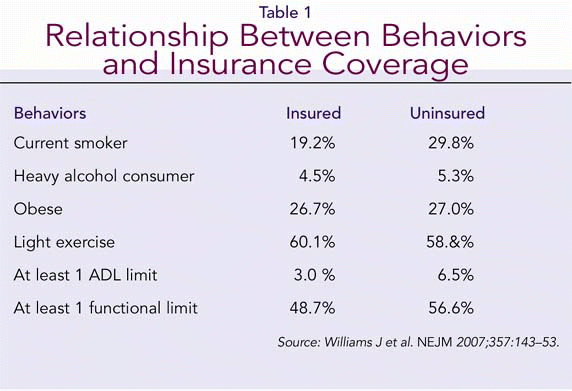Like other physicians, Gady Har-El, MD, Chairman of the Department of Otolaryngology-Head and Neck Surgery at Lenox Hill Hospital in New York and president of the American Broncho-Esophagological Association, takes on uninsured patients who have waited too long to see a doctor. I see people who are suffering from late-stage cancer, complicated comorbidities from smoking, and uncontrolled diabetes. With older patients, delays in treatment can be especially serious, he said.
Explore This Issue
November 2007For uninsured middle-aged Americans-those between ages 50 and 64-with chronic illnesses, the wait to receive Medicare at age 65 may be laden with nonreimbursable bills for doctor visits and hospitalizations. A recent New England Journal of Medicine article attempted to quantify just how much waiting for insurance costs a vulnerable population (Williams J, Meara E, et al. Use of health services by previously uninsured Medicare beneficiaries. NEJM 2007;357:143-53).
The authors collected longitudinal data between 1992 and 2004 on 5158 adults who were either privately insured continuously for five out of the six years immediately preceding their Medicare eligibility or uninsured before Medicare coverage began at age 65. They hypothesized that previously uninsured adults with chronic conditions who start receiving Medicare at age 65 have greater morbidity and require more intense and costlier care over subsequent years than they would if they had been insured previously.
Study participants self-reported their use of doctor visits, hospitalizations, and medical costs. Among 2951 adults with hypertension, diabetes, heart disease, or stroke diagnosed before age 65 years, previously uninsured adults who acquired Medicare coverage at age 65 stated they had 13% more doctor visits and 20% more hospitalizations than their continuously insured peers. The authors also suggest that the cost of subsidizing health insurance for the target group might be partially offset by future cost savings.
Although the study has drawn significant attention from advocates for the uninsured, it has flaws. Data on doctor visits, hospitalizations, and medical costs were self-reported rather than independently validated. Discrepancies between the percentages of insured and uninsured study participants who engaged in certain behaviors, glossed over by the authors, deserve a closer look (see Table 1).
Ties to Physicians
Joel Levine, MD, Chairman of the American College of Physicians’ Board of Regents and Professor of Medicine at the University of Colorado School of Medicine, said of the research: The study isn’t rocket science, but it shows that not having insurance reduces the number of services patients get. When they have insurance they use it. He also points out that people without a primary care physician are missing more than medical care. They don’t have the social system and cultural context to interpret how their behaviors such as smoking and alcohol impact their health. They enter the health system in the most inept and costly way, via the emergency room. And ERs don’t know what other ERs are doing, so the patient ends up with seven CT scans from visits to different ERs. In contrast, having a relationship with a physician helps patients realize that somebody cares and that they’re not excluded from the health care system, said Dr. Levine.

Leave a Reply